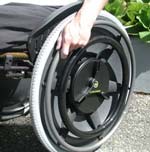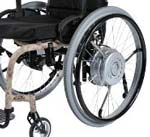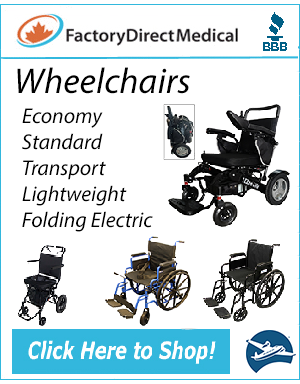
Manual Wheelchair Propulsion Assist Devices
Propulsion assist devices for manual wheelchairs can be great options for people who lack the strength and stamina to propel their wheelchairs through out the day.
While many people may move to a conventional power wheelchair when faced with propulsion problems while using their manual wheelchair, power wheelchair present some problems that are not easily overcome. Power wheelchair rarely fold for storage and loading into smaller vehicles and if they do, they tend to be bulky and heavy.
There are two popular types of propulsion assist devices on the market today. One is a manual assist that uses gear rations to reduce the effort required to propel the wheelchair and the other is a power assist that uses a battery powered motor to reduce the the effort.
Manual Propulsion Assist
Discontinued
Magic wheels are compatible with most manual wheelchairs on the market today in North America (some models may require an adapter plate) and replace the wheels that come standard on the wheelchair. They can be purchased at the same time as the wheelchair is purchased or added on at a later date as the need becomes apparent.
How the Magicwheels function:

The Magicwheel handrims multiply the power exerted by a system of gears in the wheel hub and cause the wheelchair to move easier than would normally be expected. The standard configuration is a two speed system which offers the user a no reduction or a 2 to 1 reduction which eases the propulsion by 50%.
The double handrim option of Magicwheels (as pictured here) give the user two handrims to choose from when propelling and two speeds per handrim effectively offering a 4 speed equivalent.
There are multiple handrim option to choose from depending on the needs of the wheelchair user. They are available in aluminum anodised, plastic coated, foam coated or projection. If a double handrim option is chosen the user can opt for one type of handrim for the inner handrim and a different style for the outer handrim as needs dictate.
Power Assist Wheels
Power propulsion assist wheels have motors built into the hubs of the wheels to enhance the user's power when propelling the wheelchair. Power to the power assist wheels can be turned off when not needed to conserve battery power and the wheels can be easily removed from the chair and be replaced by the original wheels reinstalled without tools.
Power assist wheelchair wheels can be purchased in at the same time as the wheelchair or can be added to most manual wheelchairs as the need becomes apparent.
How the power assist wheels function:

Quickie XTender
When the wheelchair user pushes on the hand rim, the hand rim on the power assist wheels senses the pressure exerted and signals the motor in the wheel hub to start turning in the same direction the user is pushing. If the user pushes the rims in a forward motion the wheelchair is propelled forward by the motors and if the user pulls the hand rims back the motors are signalled by the hand rims to turn backwards and propel the wheelchair backwards. Because each wheel has its own motor and is controlled independently by its own hand rim, the user can push each wheel in an opposite direction to turn the wheelchair as they normally would but will be assisted by the motors throughout the turn.
When the wheelchair users remove their hands from the hand rims or stop exerting pressure either forward or backward on the hand rims the motors stop running. Because of the sensitivity of the hand rims and the power assist wheel motors some training and practice using power assist wheels is required for the wheelchair user to be proficient and safe during use. Anti-tippers should be used on wheelchairs to prevent accidental rear ward tipping when the power assist wheels are in use.



 Online Vendors
Online Vendors  US Online Vendors
US Online Vendors 

